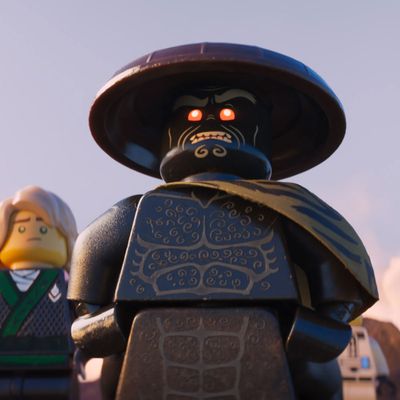
If you are not a child, or do not have children yourself, you may find the mere title of The Lego Ninjago Movie to beg some kind of explanation. I’ll do what I can. Ninjago, which I have been mistakenly pronouncing “ninja-go” for the past month, is a series of Lego sets that began production in 2011. The theme is a kind of blenderized mix of martial arts and mecha imagery; basically Power Rangers without elbow or knee joints. There are robots in the Ninjago universe, but there are also dojos, where the Japan-via-Denmark art of “Spinjitzu” is taught. I was somewhat scandalized to discover that there are actual characters in the Ninjago universe, namely the five ninjas that fight the evil warlord Garmadon, a kind of cross between a samurai and a Japanese oni beast.
The original Lego Movie was, on paper, a cynical venture, made less so by its insistence on the kind of creativity the colorful blocks have supposedly been all about. The enemy in that film was perfection, the impulse to replicate the constructions on the front of a Lego set box down to the brick. Characters and ideas — the Kragle, Cloud Cuckoo Land — had the kind of improvised, imperfect quality of something named by a kid who was world-building as he went along (which turned out to be the case). One film later, and the franchise had attached itself to an established mythology (The Lego Batman Movie), though the limitations and absurdities of the bricks and mini-figures themselves were still the selling point.
Now, with Lego Ninjago Movie, we are fully in Proprietary Legoland, and what’s being sold is nothing so vague as “the creative spirit.” Our heroes are exactly as they appear on the shelves of Toys R Us (or perhaps more accurately, the product pages of Amazon.com.) They are Kai, the fire ninja, and Cole, the earth ninja (needlessly voiced by Michael Peña and Fred Armisen, respectively); Zane, the ice/robot ninja (Zach Woods, basically doing one long “how do you do, fellow kids” bit); Nya, the water ninja (Abbi Jacobson); and Jay, the lightning ninja (Kumail Nanjiani); and finally Lloyd, the green ninja (Dave Franco), shamed son of Garmadon himself. This array of trending comic voices is obviously not for the benefit of the kids the film is aimed at, and not even entirely for their hip parents, most of whom wouldn’t know a Portlandia reference if it flew into their head. Rather, these names are to maintain the impression that the Lego movies are still as hip and irreverent as ever. The problem is that any actual subversion in the text itself has been quietly replaced by an ad for Nya’s sweet spider mecha (built box-perfectly, of course.)
So rather than a satire of a generic hero narrative, or even a specific branded one, Ninjago is a confounding hybrid: a vague mash-up of martial arts, giant monster, and mecha genres, set in an even vaguer Asian-fusion metropolis with the additional layer of obfuscation in the form of the Legos themselves. I once wrote about the conceptual marvel of the movie of Fifty Shades of Gray, a film adaptation of a book adaptation of a fanfiction tribute to the Twilight series. The Lego Ninjago movie might just have it beat. The seven-deep staff of writers try to paper over this with the kind of internet-y humor Phil Lord and Chris Miller used to jettison the original film to popular adoration. But there’s no there there, and the film never seems to know what it’s playing with besides the idea of movies in general.
The plot concerns teenaged Lloyd, whose father Garmadon (Justin Theroux, with an impressively convincing Will Arnett impression) terrorizes the citizens of Ninjago on a daily basis while Lloyd keeps him at bay with his ninja team. Everyone at school hates Lloyd because of his father; they don’t know about his heroic double life. Eventually, Garmadon conquers the city, and Lloyd must use his training from Master Wu (Jackie Chan) to use the power of teamwork and reconnect with his father and other expected things. Of course, the film gets plenty of jokes in about how played-out these plot developments are, but as in The Lego Movie, I couldn’t help but hear the words of Jon Benjamin’s can of vegetables in Wet Hot American Summer: “If you’re gonna make a formulaic movie, make a formulaic movie. Just be honest about it.”
Inevitably the “real world” makes a cameo in the land of Ninjago, in the form of a cat who attacks the city in a Godzilla-like scene of terror. It’s the most fun the film has, and the most free-form it gets with its chosen medium. But the film knows what business it’s in, and it’s not the cat-adoption business. It’s the martial-arts–giant-robot–Asian-fusion Lego business, and don’t you forget it.

